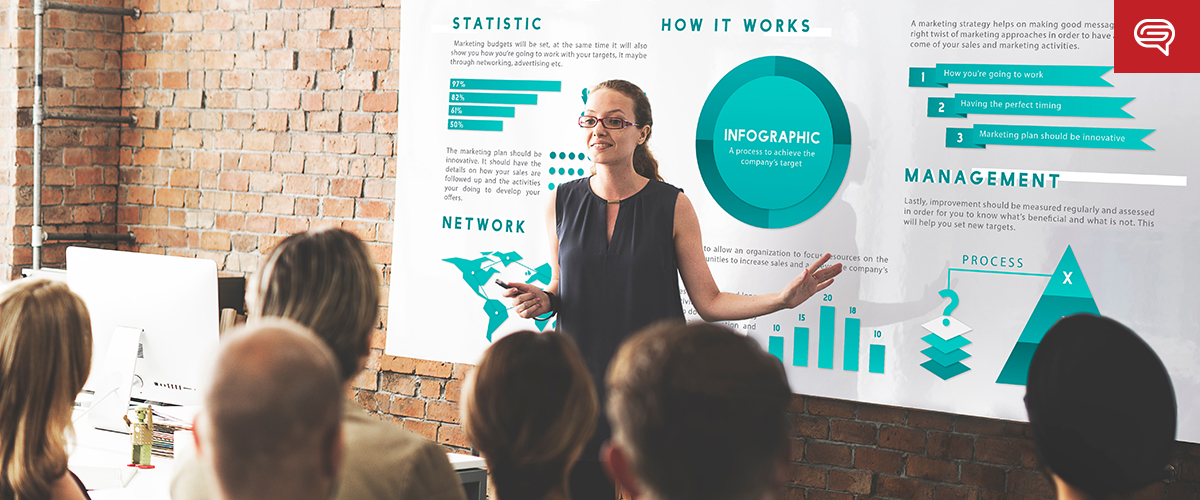Technological advances have given us access to a variety of tools, from PowerPoint slides to interactive apps that bridge the gap between audience and presenter.
However, when all your equipment starts to fail, your voice is the one presentation tool you can use without having to worry about technical requirements in the venue.
But using your voice isn’t just about saving yourself from unexpected technical difficulties. It’s also a useful way to connect with your audience.
Hearing a voice that’s clear, confident, and enthusiastic will encourage them to engage with the message. It’s not enough to stammer through your pitch while reading note cards or slides. Use your voice to deliver a winning speech.
Here are a few things to help you do just that:
Volume and Clarity
Always be mindful of the fact that you’re speaking in front of an audience. A presentation isn’t a one on one conversation.
Renowned speech evaluator, Andrew Dlugan writes on his Six Minutes blog about the role the volume of your voice plays in delivering a clear and understandable pitch.
There are plenty of people that need to hear you, but this doesn’t mean that you have to shout. Just make sure you’re articulating every word and speaking louder than you normally would in everyday scenarios. If there’s a microphone available in the venue, still be mindful of your modulation and articulation.
Intonation and Emphasis
More than a loud and clear voice, it’s also important to add some variety to your speech. A monotonous voice isn’t exactly engaging. Practice your intonation by changing your pitch and adding color and interest in your presentation. It also creates an emotional impact your audience can relate to.
For example, the statement “will you help me out” can be read in different ways depending on your intonation. With a falling intonation or by ending at a lower pitch, the statement can sound aggressive and impatient. On the other hand, a rising intonation (also called a high final pitch) indicates a sincere question.
Experiment with your approach on your speech by emphasizing different keywords and phrases.
Pausing and Pacing
What use are all the previous techniques if you end up racing through your presentation? You can have a loud voice or use appropriate intonation. Long-time actor and Speakers & Artists International, Inc. CEO, Eric Stone, emphasizes the importance of speech pauses in creating a bigger impact on your listeners.
The audience will feel lost if you speed through your presentation. Pause help pace your speech at the right moments.
To use your voice properly, know when not to use it at all. In our previous point, we made a case for emphasizing certain words and phrases that are important to your presentation. Pairing that with correct rhythm and pausing will definitely add to the impact. This gives your audience a chance to absorb the information you’re presenting and even heighten its sense of urgency and importance.
When preparing for a presentation, we often focus all our energy and resources to making sure we have the most eye-catching visuals and content. It’s also important to learn the proper way to wield your most valuable presentation tool. To be a great communicator, you need to know how to utilize your voice.
References
“5 Presentation Tools to Encourage Audience Interaction.” SlideGenius, Inc.. January 12, 2015. Accessed January 28, 2015.
“Presentation Set Up: 5 Things to Do Before You Start Speaking.” SlideGenius, Inc.. September 2, 2014. Accessed January 28, 2015.
“Troubleshooting Your PowerPoint Display Issues.” SlideGenius, Inc.. October 21, 2014. Accessed January 28, 2015.
“The Art of Speaking Is the Art of Pausing by Eric Stone.” Succeed When You Speak. October 31, 2010. Accessed January 28, 2015.
“Volume and the Public Speaker: Be Heard and Be Effective.” Six Minutes. August 19, 2013. Accessed January 28, 2015.





